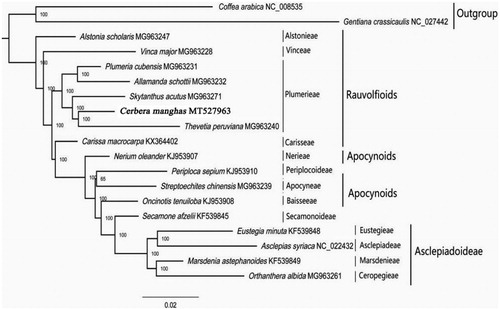Abstract
The complete chloroplast genome of Cerber amanghas L., a species of the tribe Plumerieae of the family Apocynaceae, is determined for the first time here. The chloroplast genome is 154,428 bp long, containing a large single-copy region (LSC) of 85,138 bp and a small single-copy region (SSC) of 17,390 bp, which are separated by a pair of 25,950 bp long inverted repeat regions (IRs). It encodes a total of 115 genes, including 81 unique protein-coding genes, 30 unique tRNA genes, and 4 unique rRNA genes.Phylogenetic analysis revealed that C.manghas is a member of the paraphyletic tribe Plumerieae of Apocynaceae and is closely related to Thevetia peruviana.
Cerbera belongs to the tribe of Plumerieae (Apocynaceae), small trees, sometimes shrubs, distributed in Madagascar and the Seychelles and from Japan (Ryukus) to Australia (Queensland) and Pitcairn (Endress et al. Citation2018). Cerbera manghas, the type species of the genus, grows by the sea, often is used as a landscape tree species inland (Agendae Academiae Sinicae Edita Citation1977). In addition, it has been used as the traditional medicine in some regions (Norton et al. Citation1973; Hiên and Navarro-Delmasure Citation1991; Zhang et al. Citation2010). Plastome phylogeny of Apocynaceae has been established that based on the largest sampling of molecular characters (Fishbein et al. Citation2018). However, the data for C. manghas is still lacking. Here we provide the chloroplast genome of C. manghas for the first time.
We obtained fresh leaves of C. manghas from South China Agricultural University (113°20′42.23″E, 23°9′32.66″N) and the specimen (voucher GZ708) was deposited at the South China Agricultural University Herbarium (CANT). We used Plastid Genome Annotator (PGA) (Qu et al. Citation2019) for chloroplast gene annotation and further correction in the Geneious Prime 2019 (https://www.geneious.com) and submitted them to GenBank (ID:MT527963).
The size of a chloroplast genome of C. manghas is 154,428 bp, including a large single copy (LSC, 85,138 bp) region, a small single copy (SSC, 17,390 bp) region and two inverted repeat (IR, 25,950 bp) regions. The circular genome contains 115 genes, including 81 unique protein-coding genes, 4 unique rRNA genes and 30 unique tRNA genes. The overall A-T content of the circular genome is 62.0%, while the corresponding values of the LSC, SSC, and IR regions are 64.0%, 67.7%, and 56.9%, respectively.
18 chloroplast genomes were selected for their phylogenetic establishment using the maximum likelihood (ML) criterion in IQ-TREE (Nguyen et al. Citation2015). Two species, Gentiana crassicaulis (Gentianaceae) and Coffea arabica (Rubiaceae), were used as outgroups. The results support C.manghas in Plumerieae, and it is close to Thevetia peruviana (). The chloroplast genome provides a resource for the phylogenetic studies of Apocynaceae.
Figure 1. ML phylogenetic tree of C. manghas with 18 species was constructed by chloroplast plastome sequences. Numbers on branches are boot strap support values. (The division of tribes and subfamilies refers to the (Endress et al. Citation2018)).

Disclosure statement
No potential conflict of interest was reported by the author(s).
Data availability statement
The data that support the findings of this study are openly available in NCBI at https://www.ncbi.nlm.nih.gov/, reference number is MT527963.
References
- Agendae Academiae Sinicae Edita. 1977. Flora reipublicae popularis sinicae. Vol. 63. Tomus: Science Press Beijing; p. 33–35.
- Endress ME, Meve U, Middleton DJ, et al. 2018. Apocynaceae. In: Kadereit JW, Bittrich V, editors. Flowering plants. Eudicots: Apiales, Gentianales (except Rubiaceae). Cham: Springer International Publishing; p. 207–411.
- Fishbein M, Livshultz T, Straub SCK, Simões AO, Boutte J, McDonnell A, Foote A. 2018. Evolution on the backbone: Apocynaceae phylogenomics and new perspectives on growth forms, flowers, and fruits. Am J Bot. 105(3):495–513.
- Hiên TTM, Navarro-Delmasure C. 1991. Toxicity and effects on the central nervous system of a Cerber aodollam leaf extract. J Ethnopharmacol. 34(2):201–206.
- Nguyen L-T, Schmidt HA, von Haeseler A, Minh BQ. 2015. IQ-TREE: a fast and effective stochastic algorithm for estimating maximum-likelihood phylogenies. Mol Biol Evol. 32(1):268–274.
- Norton TR, Bristol ML, Read GW, Bushnell OA, Kashiwagi M, Okinaga CM, Oda CS. 1973. Pharmacological evaluation of medicinal plants from western Samoa. J Pharm Sci. 62(7):1077–1082.
- Qu X-J, Moore MJ, Li D-Z, Yi T-S. 2019. PGA: a software package for rapid, accurate, and flexible batch annotation of plastomes. Plant Methods. 15(1):50
- Zhang XP, Pei YH, Liu MS, et al. 2010. Chemical constituents from the leaves of Cerbera manghas. Asia-Pac J Trop Med. 3(2):109–111.
